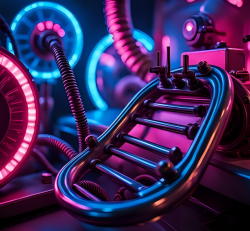Many years ago, I was a pediatric oncologist for about six years as part of my career. Nearly all the children that I tried to treat died. It was a very stressful occupation and I gave the job to a successor and took up another interest. The chief of radiotherapy had become a friend and not very long before I gave up oncology, I was having lunch with him one day. He asked me whether I had a patient with leukemia in the hospital at that time. I replied that I did indeed have an 18-year-old girl with the variety of leukemia known as myelogenous. This particular form of leukemia was at that time the most resistant to all types of treatment. I knew that the state of her disease was critical and I did not expected her to survive. In fact her death was predictably imminent.
I asked my friend why he had posed this question. He replied that he wanted to take a unit of blood from a patient with leukemia, irradiate it and put it back into the patient. Naturally, I asked him why on earth he had conjured up this experiment. In fact I knew that blood irradiation as a treatment for leukemia had been tried with little or no success. He replied that he had had a patient with Hodgkin’s disease (cancer of the lymph glands). He had irradiated swollen cancerous glands in the patient’s neck and to his surprise, glands in the groin area disappeared. He had come to the conclusion that irradiating the neck glands had released something into the bloodstream that had an effect on the glands in the groin.
Well, I said, if you can get the blood from my patient, treat it and put it back before the patient passes on, you are welcome. He took a unit of blood and put it under the cobalt bomb (the most up-to-date way of carrying out therapeutic irradiation), turned the machine on and went for lunch. When he came back he found that he had delivered 13,000 rads (a rad is a unit of x-ray dose). When you consider that 1000 rads given to a patient could be lethal, please be aware that this dose was given to a unit of blood, not the patient. He put the blood back into my patient and to my incredible surprise, she went into a clear-cut remission. I sent her home with a modest dose of an anti-leukemia drug. She relapsed about a year later and died.
Remember, at that time our treatment of acute leukemia was unpredictable. When you achieved a remission, relapse would take place sooner or later. For this type of leukemia to produce a remission that lasted a year was impressive. In fact my friend and I did the same thing with six more children with leukemia and each of them went into remission. Although remissions didn’t last, at least one of these patients was in the end-stage of the disease after two remissions had relapsed and was not expected to respond again. Well, obviously we needed data and we asked for a meeting with the specialists known as hematologists who took care of adult leukemia. We presented the facts as we had seen them and to our great surprise, the skepticism was obvious. The whole idea was rejected and no further interest was shown by our colleagues. I went to the Research Division and I was told that they had a research project that they were following and could not take on any further work.
Because we could not collect sufficient data, we were unable to publish this in a medical journal and it has been on my conscience ever since. I have tried to get numerous physicians interested, but skepticism has always abruptly ended our conversation. I write this with the hope that somebody might read about this experiment who is in a position either to begin personal research or report it to somebody else that can. The treatment of leukemia in children is still devastating although it has advanced considerably since my years of oncology.
We Need Your Help
More people than ever are reading Hormones Matter, a testament to the need for independent voices in health and medicine. We are not funded and accept limited advertising. Unlike many health sites, we don’t force you to purchase a subscription. We believe health information should be open to all. If you read Hormones Matter, like it, please help support it. Contribute now.
Yes, I would like to support Hormones Matter.
Photo by Aditya Romansa on Unsplash.














